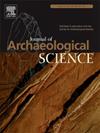Bioarchaeological perspectives on the ancient Han-Xiongnu war: Insights from the Iron Age site of Bayanbulag
IF 2.6
1区 地球科学
Q1 ANTHROPOLOGY
引用次数: 0
Abstract
The Han-Xiongnu War, a series of pivotal conflicts between the two most powerful empires in early Iron Age Eastern Eurasia, was investigated through an integrated multidisciplinary approach encompassing genetics, geology, anthropology, and archaeology. This study focuses on the analysis of a mass grave at the Bayanbulag site (BBS) in Mongolia, initially identified as a Xiongnu fortress. Our primary objective was to identify the individuals buried in the grave, providing deeper insights into the tactics and interactions of the Han-Xiongnu War. Through meticulous archaeological and anthropological investigation, we confirmed the site's war-related nature, evidenced by the fortress's architecture, excavated weapons, and trauma on the remains. Genomic analysis of the remains revealed a genetic affinity with present-day Han and ancient Northern Chinese populations. Strontium isotope analysis offered the critical evidence of the individuals' military affiliation, indicating their origin from regions beyond the Mongolian Plateau, specifically North China and the Central Plains, confirming their identity as Han soldiers. This result is further supported by carbon and nitrogen stable isotope analysis, which revealed dietary characteristic of agricultural populations from North China. By integrating data from various disciplines in a mutually supportive manner, our study presents a comprehensive account of the Han-Xiongnu War, offering new insights into the military organization and strategic engagements of the period. This interdisciplinary approach significantly enriches the historical narrative and contributes to the existing body of knowledge on early Eastern Eurasian conflicts.
古汉匈奴战争的生物考古学视角:来自巴音布鲁克铁器时代遗址的启示
汉匈奴战争是铁器时代早期欧亚大陆东部两个最强大帝国之间的一系列关键冲突,通过综合多学科方法包括遗传学,地质学,人类学和考古学进行了研究。本研究的重点是对蒙古巴音布鲁克遗址(BBS)的一个万人坑进行分析,该遗址最初被确定为匈奴堡垒。我们的主要目标是识别埋葬在坟墓里的人,为汉匈奴战争的战术和相互作用提供更深入的了解。通过细致的考古和人类学调查,我们通过堡垒的建筑、出土的武器和遗迹上的创伤证实了该遗址与战争有关的性质。对这些遗骸的基因组分析显示,他们与现代汉人和古代中国北方人有遗传亲缘关系。锶同位素分析为这些个体的军事归属提供了关键证据,表明他们来自蒙古高原以外的地区,特别是华北和中原地区,证实了他们的汉族士兵身份。碳氮稳定同位素分析进一步支持了这一结果,揭示了华北农业人群的饮食特征。通过以相互支持的方式整合不同学科的数据,我们的研究呈现了汉匈奴战争的全面描述,为该时期的军事组织和战略交战提供了新的见解。这种跨学科的方法极大地丰富了历史叙述,并有助于对早期欧亚东部冲突的现有知识体系。
本文章由计算机程序翻译,如有差异,请以英文原文为准。
求助全文
约1分钟内获得全文
求助全文
来源期刊

Journal of Archaeological Science
地学-地球科学综合
CiteScore
6.10
自引率
7.10%
发文量
112
审稿时长
49 days
期刊介绍:
The Journal of Archaeological Science is aimed at archaeologists and scientists with particular interests in advancing the development and application of scientific techniques and methodologies to all areas of archaeology. This established monthly journal publishes focus articles, original research papers and major review articles, of wide archaeological significance. The journal provides an international forum for archaeologists and scientists from widely different scientific backgrounds who share a common interest in developing and applying scientific methods to inform major debates through improving the quality and reliability of scientific information derived from archaeological research.
 求助内容:
求助内容: 应助结果提醒方式:
应助结果提醒方式:


